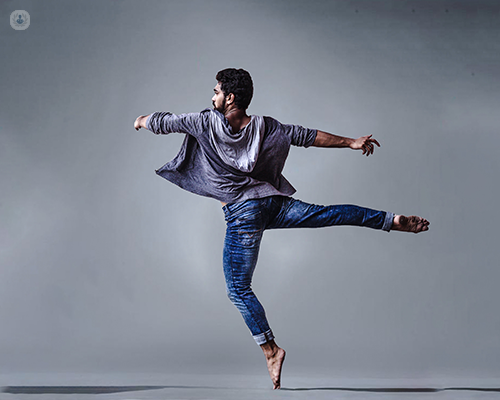How to treat and prevent ankle sprains (for dancers)
Escrito por:Foot and ankle injuries are some of the most common injuries in dancers. Of these, ankle ligament sprains and strains are by far the most common.
Naturally, dancers are keen to recover as soon as possible, and with the help of orthopaedic specialists such as Mr Rohit Madhav, this can be achieved in a way that minimises time away from dancing, but that also doesn’t compromise a full recovery.

Are dancers as susceptible to injury as sports players and athletes?
Dancers require fine proprioception, coordination, extreme flexibility and fine motor control together with strength, stamina and perseverance. Professional dancers execute physically challenging movements while making them look beautiful and artistic. They combine performing arts with a highly rigorous athletic sport. These physical demands make them just as susceptible as footballers and other athletes to injury.
How common are ankle sprains in dancers?
Up to 95 per cent of ballet dancers and 82 per cent of modern dancers will have at least one form of injury per year, and about 54 per cent of these injuries involve the foot and ankle. Ankle ligament sprains and strains are by far the commonest of these injuries.
What is the correct form of treatment to promote faster healing?
It is generally accepted that non-surgical “functional” treatment consisting of cold therapy, compression, and early mobilization by weight-bearing with a protective brace is efficacious. However, 20 to 40 per cent of grade 3 ankle ligament sprain injuries go on to have residual pains, and/or are limited and altered during their activities.
More severe sprains, therefore, ought to be assessed quickly by a specialist like myself, with rapid access to scanning to establish the appropriate diagnosis and guide the recovery treatment protocol. Early repetitive sprains can lead to chronic ligament deficiency with ankle instability, ultimately requiring surgery. On the whole, the majority recover with non-surgical treatments regardless of the grade.
Other aspects of recovery should include a healthy diet and treatment with experienced physiotherapists.
Can an ankle sprain be serious enough to prevent dancers from dancing?
The goal of treatment is to try to minimize time away without compromising recovery. This is where a multidisciplinary team approach is very useful to provide a recovery plan. This may include practising certain styles and avoiding others, and implementing functional treatment. Many injuries do not require complete restriction from activity, but of course, there are always a few injuries that can necessitate time off.
When is the right time to return to class/dancing?
Ankle sprain injuries are variable in severity and so are the time frames to return. Usually, there is a progressive return that is gauged by the response to treatments, with the aim to resume full dance performances when ankle performance manoeuvres are pain-free. Most grade 2 injuries resume between four to eight weeks.
How can dancers prevent spraining their ankle?
There are personal and environmental factors to consider with the prevention of injuries:
- Primarily, it is important to have healthy nutrition and body image psychology.
- Keep well hydrated.
- Wear properly fitting clothing and shoes.
- Avoid dancing through the pain.
- Be mindful of the limits of the body and do not push too fast too soon.
- Perform proper warm-up and cool-down activities.
- Work with proper instructors, physiotherapists and trainers.
Other risk factors to be mindful of include the type of dance; the frequency of classes, rehearsals and performances; the equipment; the type of flooring and the ambient temperature.
When is the right time to visit a physiotherapist?
It is very important to work with physiotherapists, trainers and teachers all the time. Following an injury, consult a physiotherapist as soon as possible.
Mr Rohit Madhav has spent many years helping patients recover from foot and ankle injuries. Visit his profile to learn how he can help you.


